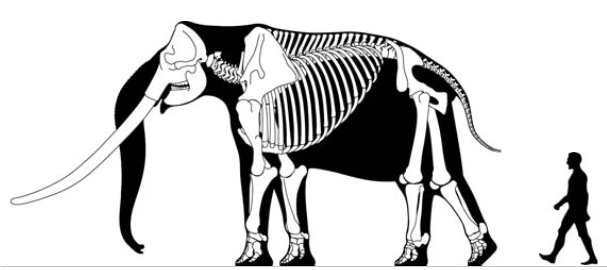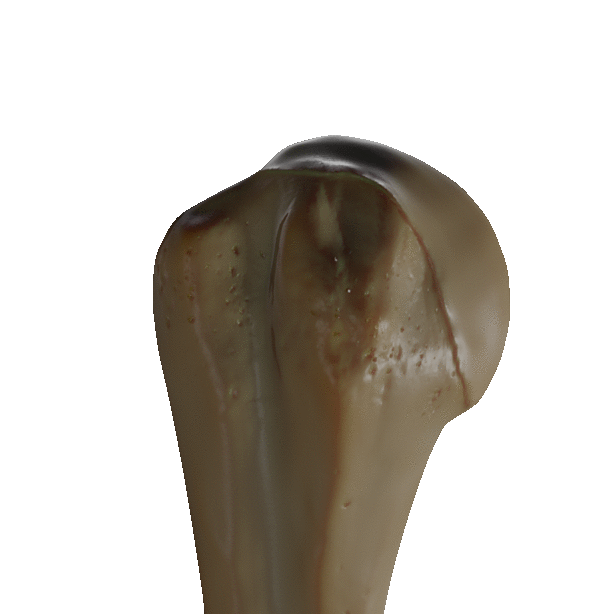|
Stegodont
''Stegodon'' ("roofed tooth" from the Ancient Greek words , , 'to cover', + , , 'tooth' because of the distinctive ridges on the animal's molars) is an extinct genus of proboscidean, related to elephants. It was originally assigned to the family Elephantidae along with modern elephants but is now placed in the extinct family Stegodontidae. Like elephants, ''Stegodon'' had teeth with plate-like lophs that are different from those of more primitive proboscideans like gomphotheres and mastodons. The oldest fossils of the genus are found in Late Miocene strata in Asia, likely originating from the more archaic ''Stegolophodon,'' shortly afterwards migrating into Africa. While the genus became extinct in Africa during the Pliocene, ''Stegodon'' remained widespread in Asia until the end of the Pleistocene. Morphology Size Some species of ''Stegodon'' were amongst the largest proboscideans. ''S. zdanskyi'' is known from an old male (50-plus years old) from the Yellow River that is ta ... [...More Info...] [...Related Items...] OR: [Wikipedia] [Google] [Baidu] |
Insular Dwarfism
Insular dwarfism, a form of phyletic dwarfism, is the process and condition of large animals evolving or having a reduced body size when their population's range is limited to a small environment, primarily islands. This natural process is distinct from the intentional creation of dwarf breeds, called dwarfing. This process has occurred many times throughout evolutionary history, with examples including dinosaurs, like ''Europasaurus'' and '' Magyarosaurus dacus'', and modern animals such as elephants and their relatives. This process, and other " island genetics" artifacts, can occur not only on islands, but also in other situations where an ecosystem is isolated from external resources and breeding. This can include caves, desert oases, isolated valleys and isolated mountains ("sky islands"). Insular dwarfism is one aspect of the more general "island effect" or "Foster's rule", which posits that when mainland animals colonize islands, small species tend to evolve larger bodi ... [...More Info...] [...Related Items...] OR: [Wikipedia] [Google] [Baidu] |
Stegolophodon
''Stegolophodon'' is an extinct genus of stegodontid proboscideans, with two tusks and a trunk. It lived during the Miocene and Pliocene epochs, and may have evolved into ''Stegodon ''Stegodon'' ("roofed tooth" from the Ancient Greek words , , 'to cover', + , , 'tooth' because of the distinctive ridges on the animal's molars) is an extinct genus of proboscidean, related to elephants. It was originally assigned to the fami ...''. Fossils have been primarily found in Asia, but some have also been reported in Africa. References Stegodontidae Miocene proboscideans Pliocene proboscideans Prehistoric placental genera Neogene mammals of Asia Fossil taxa described in 1917 {{paleo-proboscidean-stub ... [...More Info...] [...Related Items...] OR: [Wikipedia] [Google] [Baidu] |
Stegodon Aurorae
''Stegodon aurorae'', also known as the , is a species of fossil elephantoid known from Early Pleistocene (2.0 Ma – 1.0 Ma) Japan and Taiwan. Description The best-preserved ''Stegodon aurorae'' skeleton, that from Taga in Shiga Prefecture, stands to a shoulder height of , with a body length of . It is relatively short-legged, the ratio between vertebral column length and shoulder height being 0.88. The body mass of ''S. aurorae'' has been calculated at one quarter of that of its mainland ancestor ''S. zdanskyi'', which had a shoulder height of around ; as such, it is an example of insular dwarfism. Distribution Remains of ''Stegodon aurorae'' have been found in over forty-five localities in the Japanese archipelago, mainly in central Honshū. The type specimen was from Ishikawa Prefecture, while among the eight skeletons, one was found in Saitama Prefecture, two in Nagano Prefecture, one in Shiga Prefecture, one in Mie Prefecture, and three in Hyōgo Prefecture. A fragmenta ... [...More Info...] [...Related Items...] OR: [Wikipedia] [Google] [Baidu] |
Elephant
Elephants are the largest existing land animals. Three living species are currently recognised: the African bush elephant, the African forest elephant, and the Asian elephant. They are the only surviving members of the family Elephantidae and the order Proboscidea. The order was formerly much more diverse during the Pleistocene, but most species became extinct during the Late Pleistocene epoch. Distinctive features of elephants include a long proboscis called a trunk, tusks, large ear flaps, pillar-like legs, and tough but sensitive skin. The trunk is used for breathing, bringing food and water to the mouth, and grasping objects. Tusks, which are derived from the incisor teeth, serve both as weapons and as tools for moving objects and digging. The large ear flaps assist in maintaining a constant body temperature as well as in communication. African elephants have larger ears and concave backs, whereas Asian elephants have smaller ears, and convex or level backs. Elepha ... [...More Info...] [...Related Items...] OR: [Wikipedia] [Google] [Baidu] |
Proboscidea
The Proboscidea (; , ) are a taxonomic order of afrotherian mammals containing one living family ( Elephantidae) and several extinct families. First described by J. Illiger in 1811, it encompasses the elephants and their close relatives. From the mid-Miocene onwards, most proboscideans were very large. The largest land mammal of all time may have been a proboscidean; '' Palaeoloxodon namadicus'' was up to at the shoulder and may have weighed up to , almost double the weight of some sauropods like '' Diplodocus carnegii''. The largest extant proboscidean is the African bush elephant, with a record of size of at the shoulder and . In addition to their enormous size, later proboscideans are distinguished by tusks and long, muscular trunks, which were less developed or absent in early proboscideans. Three species of elephant are currently recognised: the African bush elephant, the African forest elephant, and the Asian elephant. Elephantidae is the only surviving family o ... [...More Info...] [...Related Items...] OR: [Wikipedia] [Google] [Baidu] |
Humerus
The humerus (; ) is a long bone in the arm that runs from the shoulder to the elbow. It connects the scapula and the two bones of the lower arm, the radius and ulna, and consists of three sections. The humeral upper extremity consists of a rounded head, a narrow neck, and two short processes (tubercles, sometimes called tuberosities). The body is cylindrical in its upper portion, and more prismatic below. The lower extremity consists of 2 epicondyles, 2 processes (trochlea & capitulum), and 3 fossae (radial fossa, coronoid fossa, and olecranon fossa). As well as its true anatomical neck, the constriction below the greater and lesser tubercles of the humerus is referred to as its surgical neck due to its tendency to fracture, thus often becoming the focus of surgeons. Etymology The word "humerus" is derived from la, humerus, umerus meaning upper arm, shoulder, and is linguistically related to Gothic ''ams'' shoulder and Greek ''ōmos''. Structure Upper extremity The upper or pr ... [...More Info...] [...Related Items...] OR: [Wikipedia] [Google] [Baidu] |
Femur
The femur (; ), or thigh bone, is the proximal bone of the hindlimb in tetrapod vertebrates. The head of the femur articulates with the acetabulum in the pelvic bone forming the hip joint, while the distal part of the femur articulates with the tibia (shinbone) and patella (kneecap), forming the knee joint. By most measures the two (left and right) femurs are the strongest bones of the body, and in humans, the largest and thickest. Structure The femur is the only bone in the upper leg. The two femurs converge medially toward the knees, where they articulate with the proximal ends of the tibiae. The angle of convergence of the femora is a major factor in determining the femoral-tibial angle. Human females have thicker pelvic bones, causing their femora to converge more than in males. In the condition ''genu valgum'' (knock knee) the femurs converge so much that the knees touch one another. The opposite extreme is ''genu varum'' (bow-leggedness). In the general pop ... [...More Info...] [...Related Items...] OR: [Wikipedia] [Google] [Baidu] |
Pelvis
The pelvis (plural pelves or pelvises) is the lower part of the trunk, between the abdomen and the thighs (sometimes also called pelvic region), together with its embedded skeleton (sometimes also called bony pelvis, or pelvic skeleton). The pelvic region of the trunk includes the bony pelvis, the pelvic cavity (the space enclosed by the bony pelvis), the pelvic floor, below the pelvic cavity, and the perineum, below the pelvic floor. The pelvic skeleton is formed in the area of the back, by the sacrum and the coccyx and anteriorly and to the left and right sides, by a pair of hip bones. The two hip bones connect the spine with the lower limbs. They are attached to the sacrum posteriorly, connected to each other anteriorly, and joined with the two femurs at the hip joints. The gap enclosed by the bony pelvis, called the pelvic cavity, is the section of the body underneath the abdomen and mainly consists of the reproductive organs (sex organs) and the rectum, while the p ... [...More Info...] [...Related Items...] OR: [Wikipedia] [Google] [Baidu] |
Flores
Flores is one of the Lesser Sunda Islands, a group of islands in the eastern half of Indonesia. Including the Komodo Islands off its west coast (but excluding the Solor Archipelago to the east of Flores), the land area is 15,530.58 km2, and the population was 1,878,875 in the 2020 Census (including various offshore islands); the official estimate as at mid 2021 was 1,897,550. The largest towns are Maumere and Ende. The name ''Flores'' is the Portuguese and Spanish word for "Flowers". Flores is located east of Sumbawa and the Komodo islands, and west of the Solor Islands and the Alor Archipelago. To the southeast is Timor. To the south, across the Sumba Strait, is Sumba island and to the north, beyond the Flores Sea, is Sulawesi. Among all islands containing Indonesian territory, Flores is the 10th most populous after Java, Sumatra, Borneo (Kalimantan), Sulawesi, New Guinea, Bali, Madura, Lombok, and Timor and also the 10th biggest island of Indonesia. Until the ... [...More Info...] [...Related Items...] OR: [Wikipedia] [Google] [Baidu] |
Lizardmen (Warhammer)
''Warhammer Fantasy'' is a fictional fantasy universe created by Games Workshop and used in many of its games, including the table top wargame ''Warhammer Fantasy Battle'', the ''Warhammer Fantasy Roleplay'' (WFRP) pen-and-paper role-playing game, and a number of video games: the MMORPG '' Warhammer Online: Age of Reckoning'', the strategy games '' Total War: Warhammer'', '' Total War: Warhammer II'' and '' Total War: Warhammer III'' and the two first-person shooter games in the Warhammer Vermintide series, '' Warhammer: End Times - Vermintide'' and '' Warhammer: Vermintide 2''. Warhammer is notable for its "dark and gritty" background world, which reference a range of historical cultures, along with other fantasy settings, in particular Tolkien's Middle-earth. From Michael Moorcock, its creators took the theme of "Chaos" as a force unceasingly attempting to tear the mortal world asunder. The world itself was populated with a variety of races such as humans, high elves, dark el ... [...More Info...] [...Related Items...] OR: [Wikipedia] [Google] [Baidu] |
Liang Bua
Liang Bua is a limestone cave on the island of Flores, Indonesia, slightly north of the town of Ruteng in Manggarai Regency, East Nusa Tenggara. The cave demonstrated archaeological and paleontological potential in the 1950s and 1960s as described by the Dutch missionary and archaeologist Theodor L. Verhoeven. In September 2003, an Indonesian field team and its coordinator of the excavation team, Thomas Sutikna, uncovered the first indications of a skull. Initially, the archeologists only analyzed the top of the cranium and due to the small size believed that the skull belonged to a small child. However, Sutikna and his colleagues soon discovered that its teeth were permanent and mature, revealing that it actually belonged to a fully grown adult. After a few weeks, the team had discovered most of this particular hominid's skeleton and later was coded LB1, LB2, etc., after the name of the cave. This skeleton later became the holotype specimen of ''Homo floresiensis,'' also kn ... [...More Info...] [...Related Items...] OR: [Wikipedia] [Google] [Baidu] |

_colourised.png)






